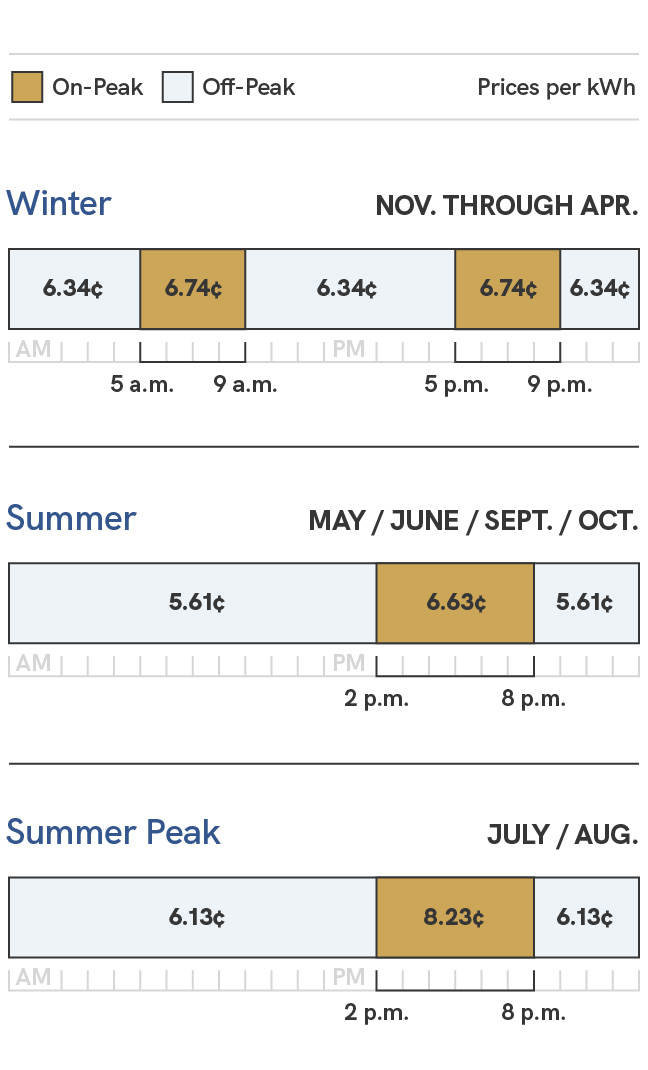
SRP solar price plans
SRP offers flexible residential solar price plans so you can choose one that’s right for you.
On this page:
On related pages:
- Customer Generation Price Plan
- Time-of-Use Export Price Plan for solar customers
- Electric Vehicle Export Price Plan
- Average Demand Price Plan
- SRP Renewable Export Program
- Conserve 6-9 p.m. and Save (Available Nov. 1)
- Manage Demand 5-10 p.m. and Save (Available Nov. 1)
- How to save on solar and demand price plans
Public pricing processSRP recently closed a public pricing process on Feb. 27, 2025. The Board voted to approve SRP Management's proposal which will take effect with the November 2025 billing cycle. For more information, please visit the price process page. |
Solar price plans
SRP offers demand- and export-based plans for customers with on-site generation (e.g., rooftop solar systems) and battery energy storage systems. There are also options available to shift from a fixed price for each kilowatt-hour you send back to the grid (e.g., SRP’s export rate) to market-based pricing, as well as a pathway to receive a capacity credit in addition to the energy credit.
Demand plans
Ideal for customers who produce some of their own energy. These plans include monthly demand charges and offer the lowest rates of all SRP residential plans.
- Customer Generation Plan — For homes with consistent energy usage. Save by minimizing demand during on-peak hours and by actively tracking and managing your usage online. See detailed plan info
- Average Demand Plan — For customers with fluctuating demand needs who want a more hands-off, worry-free approach. On this plan, you don't have to worry as much if your demand varies a lot. The per-kilowatt (kW) demand charges are higher though, so you should carefully consider which plan best meets your needs. See detailed plan info
Export plans
For customers who generate most of their own energy. Any excess energy you generate will be instantly exported by SRP and credited to your bill at a fixed price of 2.81 cents per kilowatt-hour (kWh). It’s advantageous for these customers to shift their energy use to the middle of the day, when their system is generating the most energy.
- Time-of-Use Export Plan — Save by using energy from your system and limiting grid energy use to off-peak hours. See detailed plan info
- Electric Vehicle Export Plan — For customers with electric vehicles. Save by charging overnight during super off-peak hours. See detailed plan info
Compare solar price plans
| Customer Generation | Average Demand | Time-of-Use Export* | Electric Vehicle Export* | |
|---|---|---|---|---|
| Demand-based pricing | ||||
| Net metering | ||||
| Export rate | ||||
| Winter ratesNov. through April prices per kWh | On-peak6.74¢ | On-peak6.74¢ | On-peak12.15¢ | On-peak12.15¢ |
| Off-peak6.34¢ | Off-peak6.34¢ | Off-peak9.55¢ | Off-peak10.01¢ | |
| Super off-peak8.39¢ | ||||
| Summer ratesMay/June/Sept./Oct. prices per kWh | On-peak6.63¢ | On-peak6.63¢ | On-peak22.95¢ | On-peak22.95¢ |
| Off-peak5.61¢ | Off-peak5.61¢ | Off-peak9.28¢ | Off-peak9.66¢ | |
| Super off-peak8.12¢ | ||||
| Summer peak ratesJuly through August prices per kWh | On-peak8.23¢ | On-peak8.23¢ | On-peak26.10¢ | On-peak26.10¢ |
| Off-peak6.13¢ | Off-peak6.13¢ | Off-peak9.31¢ | Off-peak9.71¢ | |
| Super off-peak8.15¢ |
Customer Generation
- Demand-based pricing
- Net metering
Winter rates — Nov. through April prices per kWh
Summer rates — May/June/Sept./Oct. prices per kWh
Summer peak rates — July through August prices per kWh
Average Demand
- Demand-based pricing
- Net metering
Winter rates — Nov. through April prices per kWh
Summer rates — May/June/Sept./Oct. prices per kWh
Summer peak rates — July through August prices per kWh
Time-of-Use Export*
- Export rate
Winter rates — Nov. through April prices per kWh
Summer rates — May/June/Sept./Oct. prices per kWh
Summer peak rates — July through August prices per kWh
Electric Vehicle Export*
- Export rate
Winter rates — Nov. through April prices per kWh
Summer rates — May/June/Sept./Oct. prices per kWh
Summer peak rates — July through August prices per kWh
How solar pricing works
SRP solar plans allow customers to offset a portion of their monthly energy bill by generating some of their own power.
A common misconception is that rooftop solar customers won’t receive an SRP bill of any kind. While that isn’t true, your monthly bill can be lower with solar generation than it would be without. Typically, solar customers continue to rely on SRP for around two-thirds of their electricity needs. SRP bills solar customers for the costs of providing electric service.
While you may save money on your SRP bill with rooftop solar, those savings are unrelated to the cost of your solar panels. Whether your SRP bill savings exceed the cost of your solar panels will depend on a variety of factors, including how the panels perform and what you paid for them.
What is the peak kW demand charge?
The peak kW demand is based on the one highest 30-minute interval during on-peak hours when the customer used the maximum or peak amount of electricity.
- The billing meter automatically takes demand measurements every half-hour during on-peak hours (excluding weekends and holidays). For example: from 2–2:30 p.m., 2:30–3 p.m., etc.
- At the end of the billing cycle, the max highest 30-minute measurement is used to compute the billed demand charge (to cover all demand throughout the entire billing cycle). Once the peak kW demand is determined, the pricing is broken into three respective tiers.
For more info, check out the cost breakdown example of the Customer Generation Plan below:

Find out how to save on solar and demand price plans. Explore your options.


